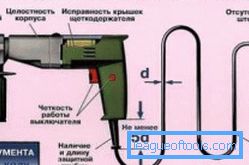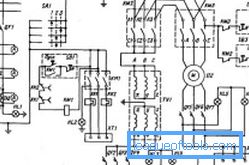How to run a manual power tool check
Tools can be divided into 2 types:
- driven by user efforts;
- devices that use energy from additional third-party sources to provide the necessary working functions.

Inspection or inspection of power tools is carried out regularly every six months.
Of the latter type, the most common and dangerous are hand power tools. Combining mechanical and electrical parts in their design, they can be a source of possible injury for users if they are not properly operated.
Therefore, each operator of such devices must understand the need for testing and know how to inspect and test the power tool that he intends to use.
Verification and verification of electric tools
There are labor protection rules that describe the algorithms of preparation for work and the use of a variety of devices and devices that are powered from the electrical network. For the entire existing list of such mechanisms, the most serious danger to users is their live parts, which, when touched to them, hit a person with an electric shock. In order to avoid the possibility of such dangerous touches, modern tools with electric drive are available with double electrical insulation, protecting the current-carrying elements of the devices. In addition, such devices are available with grounding wires embedded in the power supply cable, which are connected to the corresponding contact of the electrical plug.

Power Tool Inspection Options Before You Start.
Nevertheless, even when working with modern electrical equipment, it is necessary to observe the developed conditions for safe operation, which include their verification and verification.
The essence of these terms is as follows:
- Inspections of the power tool include a visual inspection of the entire device, examining the integrity of its body, fixing chips, breaks and cracks, as well as inspecting the power supply cable of the device for detecting scuffs and damage to the integrity of the core insulation. At the same time, the integrity of the electrical plug of the cord and the quality of its contacts are checked.
- Verification of manual electrical equipment is a more extensive, in-depth test with a certain frequency. For it, the size of the maximum possible interval between the previous and the subsequent verification is rigidly set.
Verification includes:
- Determining the integrity of the grounding conductor of the power cable by measuring it with an ohmmeter connected to the "earth" contact of the electrical plug of the cable and the point "ground" in the device itself.
- Measurement of the insulation of the electrically conductive cores of the supply cable by a high-voltage device — a megger meter (output voltage up to 500 V) is relative to the “earth” contact on the plug while the device’s power button is pressed.
- Control of the device idling for several minutes (at least 5). Measurement of insulation resistance megohm meter is carried out for 1 minute, and the obtained value should not be less than 0.5 MΩ. When checking, all actions are required that correspond to the algorithm of a regular check of a power tool.
The timing of testing power tools

Schematic diagram of the stand for testing and testing of power tools.
According to the existing regulatory documents, the largest interval between the next inspections of the electric tool is determined to be 6 months. For industries (construction enterprises), in which the conditions of use of electric tools are complicated by the influence of external factors (temperature difference, dust, exposure to aggressive media), the interval between scheduled inspections is reduced to 10 days.
It is necessary to understand that the expression “at least less than” means only that it is possible to make more frequent checks, and it is prohibited to increase the established intertesting interval.
Back to table of contentsPower Tool Checks for Professional Use
At enterprises, organizations and various structures that use power tools for professional purposes, there should be a clear record of the availability, issuance, inspection and repair of such devices. As a rule, the management of the structural unit officially appoints an employee who is fully responsible for recording, storing, issuing and checking (both current and planned) of available power tools. All necessary information on them by the responsible officer is entered in the log of the established form.
The current inspection of such devices, issued for the production of relevant works, is carried out jointly by the issuing and receiving employees. When returning the tool after completion of the work, the checking actions are carried out in the same manner. Damage detected by the inspection is officially recorded for subsequent measures to eliminate them.

Rules for the operation of power tools.
If such devices are few and without the organization of centralized storage are assigned to specific specialists, an employee who is entrusted with the task with the use of a power tool must perform an obligatory check of the tool before use.
When violations are detected in the housing fixture or in its integrity, as in the case of damage to the power cable or its plug, as well as during abnormal operation of the tool at idle (sparking of the device electric motor brushes), the tool is not allowed to be used. If it is not possible to eliminate the identified defect on its own (having the appropriate approval), then the device should be withdrawn from service, which should be promptly reported to the employee responsible for recording and checking the power tool at the structural unit.
The words about admission are far from idle, as work with electrical appliances and their parts is not allowed to every employee based on the rules of labor protection and electrical safety requirements. It follows that a routine inspection of a power tool, in which control of the insulation resistance using high-voltage measuring devices is exercised on its open current-carrying parts, cannot be entrusted to any free unit worker. Such a check can be carried out either by specialists having an appropriate electrical safety tolerance group and the necessary practical skills of such work, or special units designed for such purposes.
Back to table of contentsHousehold Electric Tool Checks
Of course, the above standards and testing algorithms have been developed for the professional use of electrical equipment and are mandatory for implementation in the professional environment, which is followed by the relevant labor protection specialists. In the domestic environment, all questions regarding the inspection of power tools and the responsibility for the negative consequences arising from non-compliance with the established rules and regulations fall on the owner of such devices.
In home devices, it is recommended, along with relevant regulatory documentation, to be guided by common sense, which suggests that the use of a faulty power tool is fraught with serious trouble. Therefore, just as in the workplace, at home the power tool must be checked every time before starting to use it.
The verification process should be carried out completely in accordance with the established for power tools regulations: monitor the reliability of mounting parts of the device, the integrity of the elements of its body, no damage to the cable supplying the device and its electrical plug, as well as the normal operation of the tool without a load. After use, the device should be prepared for further storage, for which it should be carefully cleaned of residual work, dust and dirt. If the power tool in the house is mostly stored rather than used, it is recommended that you turn it on at least once a quarter for a few minutes with no load.

Smooth start of the electric tool.
Verification of household power tools is recommended using the algorithm developed for professional devices. However, the time interval between periodic checks can be chosen longer than the standard semiannual interval. With the rare use of such a tool, it can be calibrated once a year. Aging of the materials from which such a device is made, their physical wear and tear cause a decrease in the initial quality of the product, including a decrease in the insulation resistance of the power tool. Therefore, carrying out the specified periodic inspection, the owner of the device gets the opportunity to timely detect this decrease.
However, both for professional structures and for home conditions, the same requirement applies to people who are involved in the calibration of household power tools: they must be specialists who have the appropriate admission to this work. The best solution in this case may be to contact a specialized organization or a company that checks the calibration of its power tools.
Owners of household power tools are strongly advised to carry out the established types of checks without abandoning them. It is quite possible that the deviations detected in the operation and in time eliminated in the operation of the device will save the health of the user of the power tool, not to mention life.